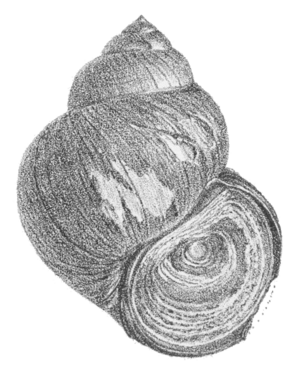Cipangopaludina cathayensis facts for kids
Quick facts for kids Cipangopaludina cathayensis |
|
|---|---|
 |
|
| Shell and operculum from type description. | |
| Conservation status | |
| Scientific classification | |
| Synonyms | |
|
Paludina catayensis Heude, 1890 (orthographic error) |
Cipangopaludina cathayensis is a type of large freshwater snail. It has a special lid called an operculum and breathes with a gill. This snail is an aquatic gastropod mollusk and belongs to the Viviparidae family, also known as river snails.
Contents
About Its Name
This snail was first described in 1890 by a French Jesuit named Pierre Marie Heude. He called it Paludina catayensis. Later, experts realized there was a small spelling mistake in the name. They corrected it to cathayensis.
For a while, some scientists thought this snail was just a subspecies of another snail, Vivipara chinensis. But more recent studies have shown that Cipangopaludina cathayensis is its own separate species.
Where It Lives
Cipangopaludina cathayensis can be found across a large part of China. It lives in central and southeastern areas. You can find it in provinces like Shandong, Anhui, Jiangsu, Zhejiang, Jiangxi, Jilin, Shanxi, Hebei, Henan, Hubei, and Hunan.
What It Looks Like
The shell of C. cathayensis can be quite big. It is usually between 24.3 and 50.5 millimeters wide. The height of the shell ranges from 27.7 to 58.5 millimeters. Each shell has about five to six whorls, which are the spiral turns of the shell. The very top of the shell, called the apex, is pointed.
This snail has gills, which help it breathe underwater. It also has an operculum, a hard plate that can close the opening of its shell. This helps protect the snail from danger.
Scientists have studied the snail's body closely. Its kidney has a unique triple shape. They also know that C. cathayensis has 18 chromosomes.
Its Habitat and Life Cycle
C. cathayensis prefers to live in calm waters. You can find it in lakes, reservoirs, and ponds. It also likes grassy areas, especially rice paddies, where it clings to water plants.
Reproduction
Female C. cathayensis snails carry many babies inside them. Each pregnant female can have more than 60 embryos. The shell of a baby snail already has three whorls when it is born.
Role in Nature
These snails can help clean water! Studies have shown that wetlands with these snails are better at removing pollution than wetlands without them.
Like many animals, Cipangopaludina cathayensis can have parasites. One type of flatworm, called Aspidogaster conchicola, can live inside these snails.
How Humans Use This Snail
| Nutritional value per 100 g (3.5 oz) | |
|---|---|
|
3.83 g
|
|
|
Protein
|
|
| Threonine | 2.952 g |
| Isoleucine | 2.026 g |
| Leucine | 5.198 g |
| Lysine | 3.700 g |
| Methionine | 1.145 g |
| Cystine | 1.233 g |
| Phenylalanine | 1.894 g |
| Tyrosine | 2.731 g |
| Valine | 1.894 g |
| Arginine | 4.537 g |
| Histidine | 1.057 g |
| Alanine | 3.524 g |
| Aspartic acid | 6.211 g |
| Glutamic acid | 9.868 g |
| Glycine | 3.340 g |
| Proline | 1.850 g |
| Serine | 2.996 g |
| Other constituents | Quantity |
| Water | 77.30 g |
| Crude fat | 0.60 g |
| Crude protein | 13.72 g |
| Crude ash | 4.55 g |
| †Percentages estimated using US recommendations for adults. | |
People use C. cathayensis as food. It is also used to make some medicines. Farmers use these snails as feed for fish, chickens, and other farm animals. Sometimes, they are even used as a fertilizer to help plants grow.
Images for kids




